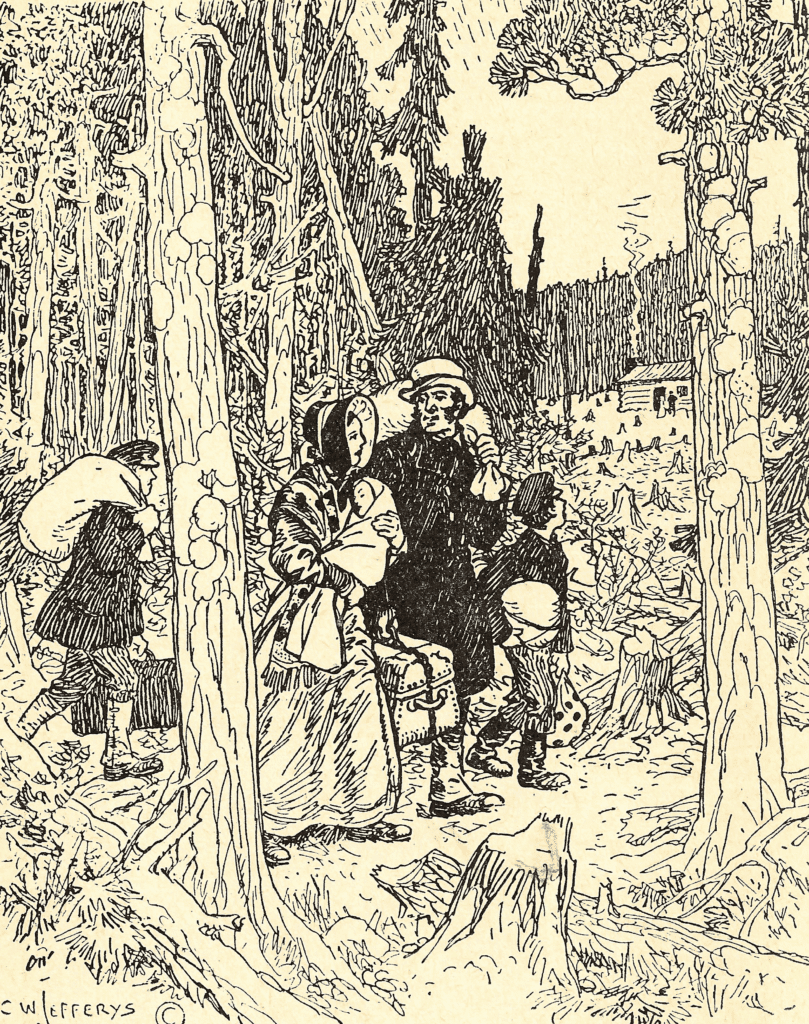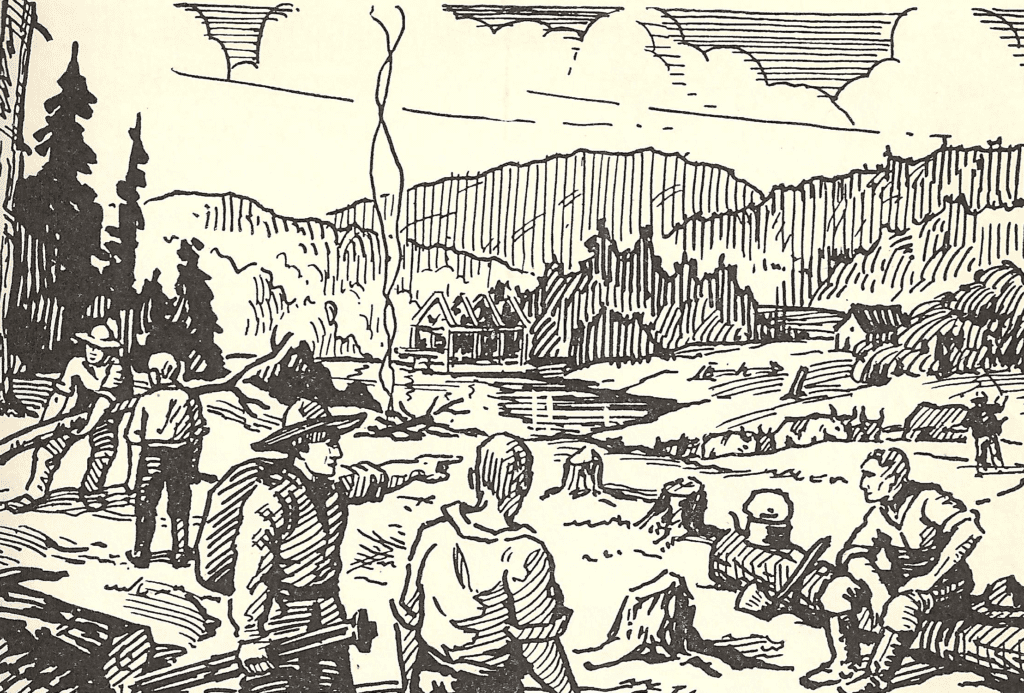Clearing Their Lot
While the Copping family had been in the colony for 10 years, they had dwelt in urban areas and thus did not have the tools or skills required to clear a lot in a virgin forest as well as to build a home.
Government instructions for settlers srongly suggested they not bring any tools with them not only as a cost saving measure but that European tools did not meet the unique specifications for clearing or building in the climate in the Canadas.
The carefully prepared list of the requirements to clear and build their home, filled during the initial stop in St.Jacques, was soon put to good use.
Everything from tools to chop and build, there were finishing items for the log cabin from a draw knife, a pair of hinges, nine panes of glass, 1 lb. of putty, 14 lbs. of nails.
Although not much in household furnishings were to be carried through the bush to the building site, Elizabeth brought basic domestic equipment. A couple kettles and a pan for cooking, a minimum of tableware, as well as one blanket for each adult member, one for every two children.
Despite the limitations necessary when leaving London, Elizabeth insisted on packing her china and linen which was also was carted through the bush to their lot on the 6th range.

Once they had reached the limit of the township the road soon became barely a track rather than a travelled road. George would have made the trek initially on his way to visit the sight where the lot was, and possibly chosen the spot on his hundred acres to build their home.
There were settlers on the first three ranges who would have made improvements on the road as far as the 3rd range but going up the mountainside for the next three ranges was a challenge. What a slog this the trek to their lot must have been, particularly with young children!
George being a new arrival in the settlement valued, in fact needed the experience of prior settlers. He and his boys participated in local bees for experience and the necessary help they required.

A Clearing Bee
Bees were very common, sometimes two or three were held in the same week. Bees were a more practical approach to work that was very labour intensive. Newly arrived settlers, such as the Coppings, could gain much experience working with seasoned hewers.
The ladies served meals for the workers, usually dinner and supper. Tea and possibly beer or whiskey was served to the men at the meals. Although the ladies did not usually accompany their men to a bee, they frequently sent contributions for the meals. In the evening the ladies and children might join the party for dance and song, and keep an eye on their men that they did not drink too much alcohol. Sometimes a little too much spirits resulted in tragedy such as the killing of Robert Brown.
The Coppings, in fact very few settlers, very seldom worked alone whether it was logging, making potash, or in the fields ploughing, planting or harvesting. In return they spent many days working at a neighbour’s farm or in the bush.
As the Copping boys grew older they attended the bees while George stayed at home to tend to business and community interests as well as seeing to the animals and working on the farm. If the bee was held at a near neighbour or close friend, he and Elizabeth joined in the evening festivities.
A few years later, as a very new bride their daughter in law, Florella Wright was faced with hosting a bee at her new home. With the help of the family she succeed very well despite this was an entirely new concept for her.
Building Their Home
George and his boys, George, William, and John, chopped and burnt every day through spring into summer. Finally there was adequate space to build as well as the logs to build a cabin.
A cellar had been be dug out and lined with small logs to store their potatoes and all other such provisions during the winter.
The house was erected over this space.
A bee made good work of getting the walls of the house up and a start on the roof made.
Holes were then cut in the walls for a door and a window. To conserve heat only one window was in a cabin.
The gables were boarded and the shingling began.
Elizabeth waited with great anticipation for the completion of the cabin.
At the end of summer, while he house was not completely finished, the family moved in.
They had a roof over their heads once again!
Before the frost came, the outside of the house was banked with earth to about a foot high around the foundation. This was done to protect the cellar from frost and limit cold drafts blowing through the house during the winter.
The family lived and expanded in this dwelling for the next fifteen years.
Elizabeth, Clarinda and James set about winterizing the cabin. The walls had to be carefully examined and any holes chinked with a mixture of moss, clay, and lime.
When the first snow arrived it would be shovelled against the sides of the cabin to help retain the heat from the one stove that provided both a cooking surface and heated the home.
Despite their efforts, during the coldest winter days, the temperature in the cabin fell well below freezing temperatures.
The ladies suffered from chapped hands and cracked fingertips. A bit of lard rubbed well into the hands helped relieve the condition. This first year there was no lanolin but the next fall there was wool to spin, and the lanolin provided lubrication for their hands.
The cabin was completed but for George and the boys, there was still plenty work to be done before winter. Logs for a stable was needed for the oxen, a cow, the pig, a couple sheep, chickens and geese. For the first year what little fodder could be garnered from the cleared area for winter feed was stored in a lean-to.
Supplies for the family had to be purchased this first season as there was no garden for vegetables nor animals for meat.
Preserving food was a challenge as there was as yet no cellar in the house. Vegetables were stored in a large, sturdy, wooden box just outside the door.
Meat was salted and kept in a barrel. Once the temperatures went below freezing, frozen meat replaced the salted fare.
When all was ready in the home and barn yard, George and his sons, George and William, went back to clearing land for spring planting.
George was always looking to make a profit and having worked in a large saw mill operation in Quebec City area, he was familiar with the various types of trees and the value of the different logs. He knew beech, maple, and hickory made good firewood and that it took many cords to heat the house during a long, cold, winter.